COMPANY RULE (1773-1858)
1. Arrival of the British East India Company (1600)
Formation: The British East India Company was established in 1600 to promote trade between Britain and the East Indies (mainly to trade in spices).
Initial Purpose: The company initially had no political aims and focused on trade, primarily in Bengal and Surat.

2. Early Expansion (17th Century)
Settlement in Surat (1612): The company set up its first factory in Surat after receiving the permission of the Mughal Emperor Jahangir.
Battle of Plassey (1757):
British forces, led by Robert Clive, defeated Siraj-ud-Daula (Nawab of Bengal), establishing British political control over Bengal.
After the victory, the British East India Company gained the Diwani rights (right to collect taxes) in Bengal, increasing its power.
3. Political and Military Consolidation (18th Century)
Battle of Buxar (1764):
The British defeated a coalition of Indian rulers, including the Mughal Emperor, the Nawab of Oudh (Awadh), and the Nawab of Bengal.
The victory solidified the British East India Company’s control over Bengal, Bihar, and Orissa.
The Diwani rights were formalized, and the Company took direct control of Bengal’s administration.
Expansion: The company gradually expanded its influence, defeating rival powers (e.g., Marathas, Mysore) and gaining control over larger areas.
Early Reforms and Growing British Control
Regulating Act of 1773
Introduced by Frederick North, also known as Lord North, to regulate the East India Company’s operations.
Established the position of Governor-General of Bengal, with Warren Hastings as the first GGB, assisted by a 4-member council (Executive Council), which also performed legislative functions.
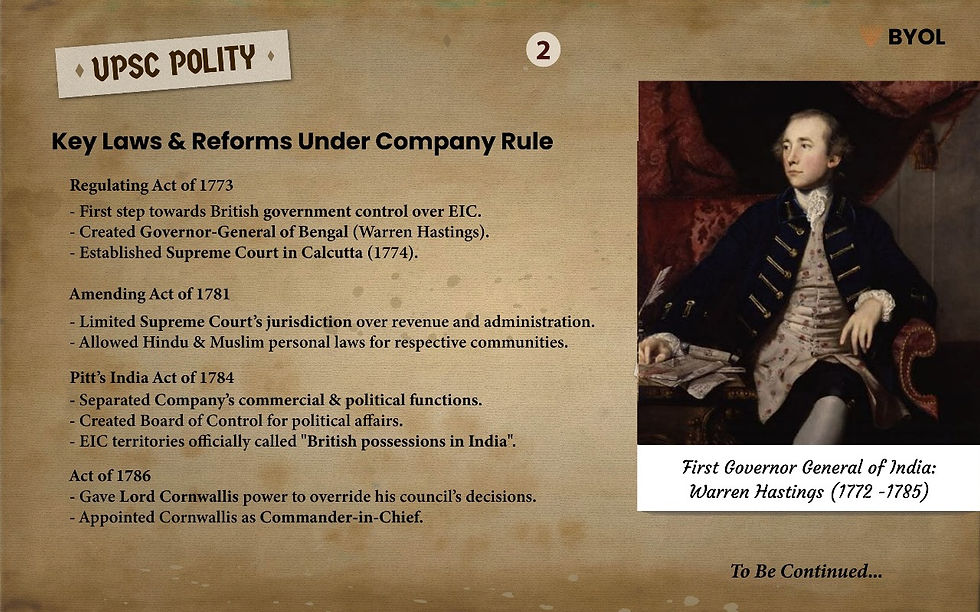
The Governor of Bombay and Madras now worked under the Governor-General of Bengal.
Established a Supreme Court at Fort William (headquarter of EIC) in Calcutta in 1774, comprising a Chief Justice and three other judges, to administer British legal principles. (Sir Elijah Impey was the first Chief Justice).
Prohibited company officials from engaging in private trade or accepting presents/bribes from Indians.
Strengthened British government control by requiring the Company’s Court of Directors to report on revenue, civil, and military affairs in India.
Amending Act of 1781
In a bid to rectify the defects of the Regulating Act of 1773, the British Parliament passed the Amending Act of 1781, also known as the Act of Settlement.
Exempted the Governor-General, the Council, and company servants from the Supreme Court’s jurisdiction for official actions.
Excluded revenue-related matters from the Supreme Court’s jurisdiction.
Gave the Supreme Court jurisdiction over all Calcutta inhabitants, applying personal laws (Hindu law for Hindus, Muslim law for Muslims).
Allowed appeals from Provincial Court to be taken to the Governor-General-in-Council, not the Supreme Court.
Empowered the Governor-General-in-Council to create regulations for provincial courts and councils.
Pitt’s India Act of 1784
The act distinguished between the commercial and political functions of the East India Company.
The Court of Directors was allowed to manage the commercial affairs, while a new body called the Board of Control was created to manage political affairs, thus establishing a system of double government.
The Board of Control was empowered to supervise and direct all operations of the civil and military government or revenues of the British possessions in India.
For the first time, the Company's territories in India were called the 'British possessions in India.'
The British government was given supreme control over the Company's affairs and its administration in India.
Act of 1786
Lord Cornwallis was appointed Governor-General of Bengal in 1786.
He demanded the power to override his council’s decisions in special cases.
He also demanded the position of Commander-in-Chief.
The Act of 1786 was enacted to grant both these powers.
Charter Act of 1793
Extended the overriding power of the Governor-General over the council to all future Governor-Generals and Governors of Presidencies.
Increased the Governor-General's control over the Bombay and Madras Presidencies.
Extended the company's trade monopoly in India for 20 more years.
It provided that the Commander-in-Chief was not to be a member of the Governor-General’s council unless he was so appointed.
Required the members of the Board of Control and their staff to be paid from Indian revenues.
Charter Act of 1813
Abolished the company’s trade monopoly in India, opening trade to all British merchants, but kept the monopoly for tea and trade with China.
Asserted British Crown sovereignty over the Company’s territories in India.
Allowed Christian missionaries to come to India to spread their teachings.
Promoted the spread of Western education among the inhabitants of British territories in India.
Authorized local governments in India to impose taxes on individuals and punish those who failed to pay.
Charter Act of 1833
This Act was the final step towards centralisation in British India.
The title of Governor-General of Bengal was changed to Governor-General of India. Lord William Bentinck became the first to hold this position.
A law member was added to the Governor-General’s Council for legislative functions. Lord Macaulay was the first to serve in this role.
The Act authorized the formation of a Law Commission to codify Indian laws, with Lord Macaulay as its chairperson.
The Governor-General was given all administrative and financial powers, centralizing governance in India.
The governors of Bombay and Madras lost their legislative powers, which were now concentrated in the hands of the Governor-General.
The British East India Company’s monopoly over tea trade and trade with China was abolished.
The Act permitted unrestricted European immigration to India and allowed them to acquire property.
The Act proposed open competition for civil servant selection and stated that Indians should not be excluded from holding positions under the Company. However, this provision was rejected due to opposition from the Court of Directors.
Laws passed under this Act were referred to as “Acts” rather than “Regulations.”.
Charter Act of 1853
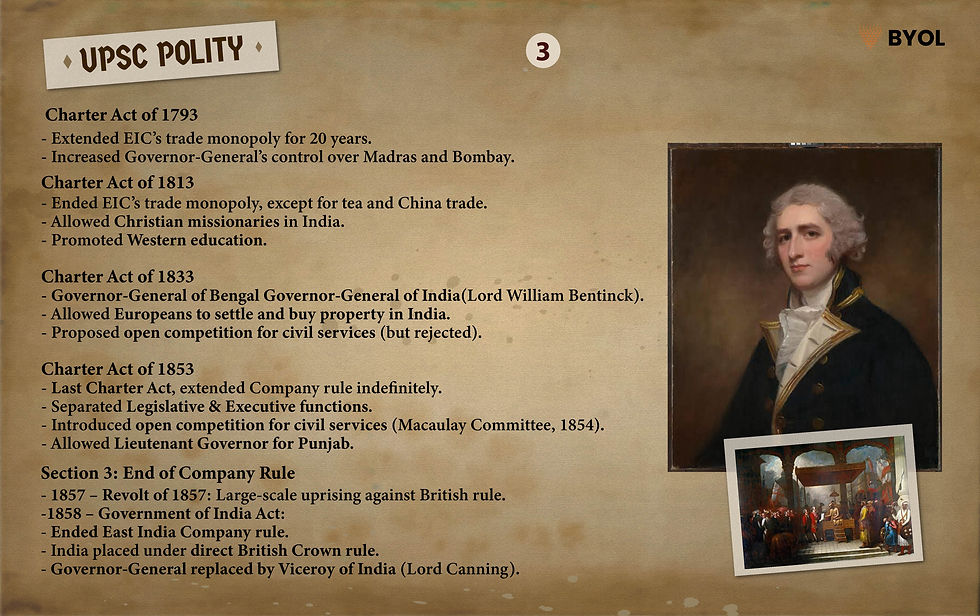
This was the last of the series of Charter Acts passed by the British Parliament between 1793 and 1853. It was a significant constitutional landmark and was introduced during the tenure of Lord Dalhousie.
The 1853 Charter Act extended the company’s rule without specifying a time period, allowing Parliament to end the rule at any time.
Formal separation of the legislative and executive functions of the Governor-General’s Council, marking a move towards a more systematic legislative process.
Established a separate Governor-General’s Legislative Council with six new legislative councillors, functioning like a mini-parliament.
The Council included key figures (Governor-General, Commander-in-Chief, members of the Governor-General’s Council, Chief Justice, and provincial representatives) and followed British Parliament procedures.
Introduced an open competition system for civil servant recruitment, extending the service to Indians, leading to the formation of the Macaulay Committee in 1854.
Four out of six new members in the Legislative Council were appointed by local governments of Madras, Bombay, Bengal, and Agra.
The number of Directors was reduced from 24 to 18, with 6 appointed by the Crown.
Empowered the Court of Directors to appoint a Lieutenant Governor for Punjab, leading to the creation of a new presidency in 1859.
The Company was made responsible for paying the salaries of the Board of Control, secretaries, and other officers.
Granted the Governor-General the power to nominate a Vice President for the Council, and required his assent for all legislative proposals.
Created a separate Governor for Bengal, distinguishing it from the Governor-General’s role overseeing the entire administration of India.
CROWN RULE (1858-1947)
"Crown rule" refers to the British Crown's direct control over India from 1858 to 1947.
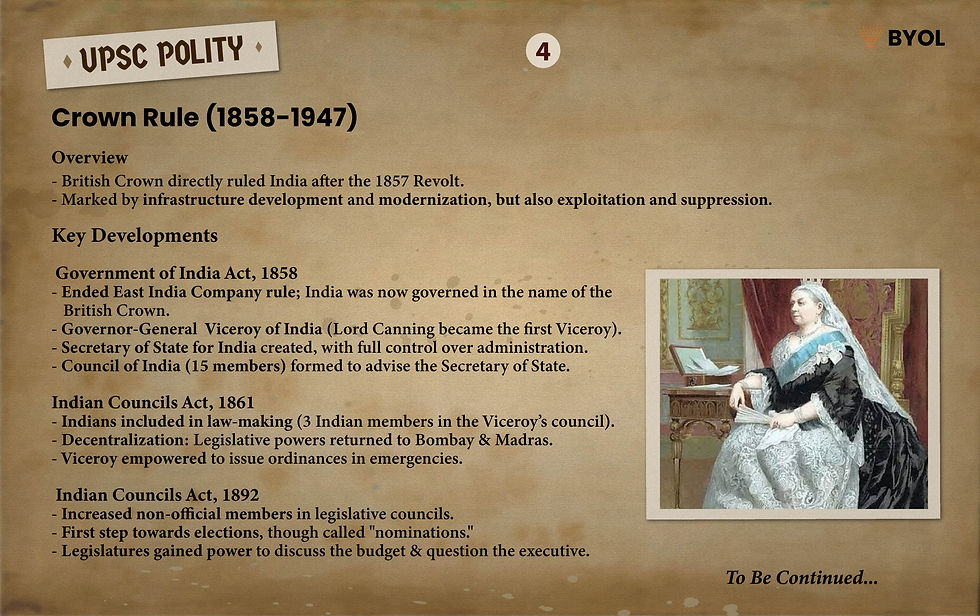
British Crown rule brought infrastructure development and modernization but was marred by exploitation and suppression, leaving a complex legacy of both progress and hardship.
1857 Revolt: The revolt, also known as the First War of Indian Independence, was a major uprising against British rule, which led to the dissolution of the East India Company.
Government of India Act 1858: After the rebellion, the British government decided to assume direct control over India, thus ending the rule of the East India Company.
Queen's Proclamation: In 1858, Queen Victoria issued a proclamation assuring protection of the rights of Indian rulers and subjects but also affirmed British sovereignty over India.
Government of India Act of 1858
The GOI Act 1858, also known as the Act for the Good Government of India (1858), marked the end of East India Company rule and transferred control of India to the British Crown.
India was now to be governed in the name of the British Crown, and the title of Governor-General of India was changed to Viceroy of India. The Viceroy would be the direct representative of the Crown. Lord Canning became the first Viceroy.
The Act ended the dual system of governance by dissolving the Board of Control and the Court of Directors of the East India Company.
A new office was created for the Secretary of State for India, who had full authority over Indian administration. The Secretary of State was a member of the British Cabinet and was ultimately accountable to the British Parliament.
The Act established a 15-member Council of India to assist the Secretary of State, serving as an advisory body. The Secretary of State became the Chairman of the Council, and it was recognized as a corporate entity capable of suing and being sued both in India and England.
While the Government of India Act 1858 improved the administrative structures and formalized British control over India, it largely maintained the existing system of governance without making substantial changes to the nature of British rule in India.
After the great revolt of 1857, the British government felt the necessity of seeking the cooperation of the Indians in the administration of their country. In pursuance of this policy of association, three acts were enacted by the British Parliament in 1861, 1892, and 1909.
Indian Councils Act of 1861
It made a beginning of the representative institutions by associating Indians with the law-making process. The Viceroy nominated Indian members as non-official members of his expanded council. In 1862, Lord Canning (Viceroy) nominated three Indians to his legislative council—the Raja of Benaras, the Maharaja of Patiala, and Sir Dinkar Rao.
Initiated decentralization by returning legislative powers to Bombay and Madras presidencies, reversing the centralization trend from the Regulating Act of 1773. This legislative devolution eventually led to significant internal autonomy for provinces by 1937.
Provided for the creation of new legislative councils for Bengal (established in 1862), North-Western Provinces (1886), and Punjab (1897).
Allowed the Viceroy to establish rules and orders for smoother council operations and recognized the 'portfolio' system introduced by Lord Canning in 1859. This system put specific government departments under the charge of individual council members.
Gave the Viceroy the power to issue ordinances without needing legislative council approval during emergencies, with such ordinances having a validity of six months.
Indian Councils Act of 1892
The Act increased the number of non-official members in both the Central and provincial legislative councils while maintaining official majorities.
Legislative councils gained the power to discuss the budget and raise questions to the executive.
Non-official members of the Central Legislative Council were nominated by the Viceroy based on recommendations from provincial councils and the Bengal Chamber of Commerce.
Non-official members of provincial councils were nominated by governors based on recommendations from district boards, municipalities, universities, trade associations, and other bodies.
The Act indirectly introduced the concept of elections for filling some non-official seats in the councils, though it used the term “nomination” instead of “election.”
Indian Councils Act of 1909 (Morley-Minto Reforms)
This Act is also known as the Morley-Minto Reforms (Lord Morley was the then Secretary of State for India and Lord Minto was the then Viceroy of India).
Raised the number of members in the Central Legislative Council from 16 to 60. Provincial councils had varying sizes.
The Central Legislative Council kept the official majority, while provincial councils had a non-official majority.
Legislative councils gained more powers, including the ability to ask supplementary questions and propose resolutions on the budget.
Indians were included in the executive councils of the Viceroy and Governors; Satyendra Prasad Sinha became the first Indian Law Member in the Viceroy's executive council.
The Act introduced communal representation by allowing Muslims to elect their own members, marking the start of separate electorates and fostering communalism. Thus, the Act ‘legalized communalism,’ and Lord Minto came to be known as the Father of Communal Electorate.
The Act also provided separate representation for presidency corporations, universities, and zamindars.
Government of India Act of 1919 (Montagu-Chelmsford Reforms)
The Government of India Act of 1919 was thus enacted, which came into force in 1921. This Act is also known as the Montagu Chelmsford Reforms (Montagu was the Secretary of State for India and Lord Chelmsford was the Viceroy of India).
Central and provincial subjects were separated, allowing both legislatures to make laws on their respective subjects, though the government remained centralized
Provincial subjects were divided into "transferred" (administered with ministers' help) and "reserved" (administered by the governor and executive council). This dual rule, known as 'dyarchy,' was largely unsuccessful.
Introduced a bicameral legislature with an Upper House (Council of State) and Lower House (Legislative Assembly). Most members were directly elected.
Three out of six members (excluding the Commander-in-Chief) of the Viceroy’s executive council were to be Indian.
Separate electorates were provided for Sikhs, Indian Christians, Anglo-Indians, and Europeans.
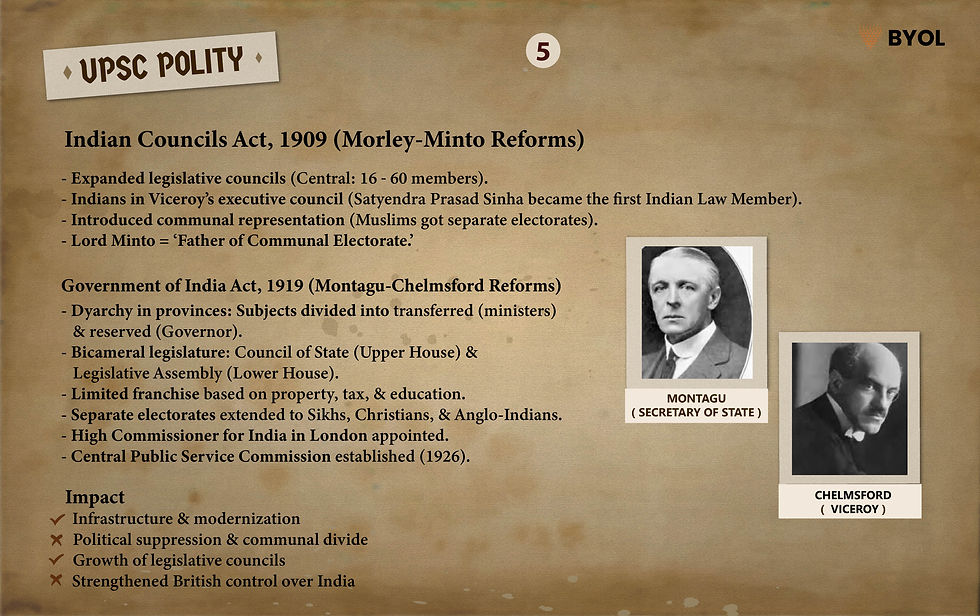
Franchise was granted to a limited number of people based on property, tax, or education qualifications.
Created the post of High Commissioner for India in London, transferring some responsibilities from the Secretary of State for India.
Established a Central Public Service Commission in 1926 to recruit civil servants.
For the first time, provincial budgets were separated from the Central budget, with provincial legislatures authorized to pass their budgets.
A commission was appointed to review the Act's implementation after 10 years.
Simon Commission
Appointment of the Commission: In November 1927, the British Government appointed a seven-member commission, chaired by Sir John Simon, to review India's condition under its new Constitution, two years ahead of schedule.
Boycott by Indian Parties: All commission members were British, leading to a widespread boycott by Indian political parties.
Report and Recommendations: The commission submitted its report in 1930, recommending the abolition of dyarchy, extension of responsible government in provinces, creation of a federation of British India and princely states, and continuation of communal electorates.
Round Table Conferences: To discuss the commission’s proposals, the British Government held three round table conferences with representatives from the British Government, British India, and princely states.
White Paper and Joint Select Committee: Based on these discussions, a "White Paper on Constitutional Reforms" was created and submitted to the Joint Select Committee of the British Parliament.
Incorporation into the Government of India Act of 1935: The recommendations of the Joint Select Committee were incorporated (with some changes) into the Government of India Act of 1935.
Communal Award
Announcement of the Communal Award: In August 1932, British Prime Minister Ramsay MacDonald introduced the Communal Award, which provided separate electorates for Muslims, Sikhs, Indian Christians, Anglo-Indians, and Europeans, and extended it to the depressed classes (Scheduled Castes).
Gandhi’s Protest: Gandhi was deeply distressed by the inclusion of the depressed classes in separate electorates and began a fast unto death in Yerawada Jail (Poona) to have the award modified.

Poona Pact: After negotiations, the Congress and the leaders of the depressed classes reached an agreement, known as the Poona Pact, which retained the Hindu joint electorate while providing reserved seats for the depressed classes.
Government of India Act of 1935
Established a Federation of provinces and princely states, dividing powers into Federal, Provincial, and Concurrent Lists. Residuary powers were given to the Viceroy. However, the Federation never materialized as princely states did not join.
Replaced dyarchy with provincial autonomy, allowing provinces to act as autonomous units. Introduced responsible government in provinces, with governors on the advice of ministers responsible to provincial legislatures (implemented in 1937, discontinued in 1939).
Introduced a system of dyarchy at the Centre, dividing federal subjects into reserved and transferred subjects. However, this provision was never implemented.
Established bicameral legislatures in six out of eleven provinces (Bengal, Bombay, Madras, Bihar, Assam, United Provinces), consisting of an upper house (Legislative Council) and a lower house (Legislative Assembly), with restrictions on their powers.
Extended separate electorates to depressed classes (Scheduled Castes), women, and labourers (workers).
Abolished the Council of India (established by the 1858 Act) and replaced it with a team of advisors to the Secretary of State for India.
Extended voting rights to about 10% of the population.
Established the Reserve Bank of India to control currency and credit.
Created a Federal Public Service Commission, Provincial Public Service Commissions, and Joint Public Service Commissions for two or more provinces.
Established the Federal Court in 1937 to resolve disputes between the Centre and provinces.
August Offer (1940)
Change of government in Britain (May 1940).
Winston Churchill became the Prime Minister.
Britain was in immediate danger of Nazi occupation.
August Offer Announced:
Date: 8 August 1940, during the Battle of Britain.
By: Viceroy of India, Lord Linlithgow (longest-serving Viceroy of India).
Purpose: Sought Indian support in WWII.
Proposals in the August Offer
Expansion of the Executive Council to include more Indians.
Dominion status to India.
Establishment of an Advisory War Council (8 Indians out of 12 members).
Giving full weight to minority opinion.
Recognition of Indians' right to frame their own constitution (after WWII).
India’s Reaction to the August Offer
Congress: Rejected the offer at Wardha on 21 August 1940 and asserted the demand for complete freedom from imperial power.
Gandhi’s View: Saw it as widening the gulf between Indian nationalists and British rulers.
Muslim League: Rejected the offer.
Jawaharlal Nehru: Stated, “Dominion status concept is dead as a doornail’’.
Cripps Mission 1942 Proposals:
Based on the draft declaration prepared by the All India Committee, chaired by Attlee, Stafford Cripps came to India and proposed the following constitutional reforms:
Dominion Status for India: Proposed creating a new Indian Union with Dominion status after World War II, equal to the UK and other dominions in both domestic and external affairs.
Constituent Assembly: Suggested setting up a Constituional Body after the war, with members elected by Provincial Assemblies and nominated by princely state rulers. The constitution would be drafted entirely by Indians.
Right to Secede for Provinces: Provinces unwilling to accept the new Constitution could either maintain their current status or create their own constitution and union.
Negotiation of Power Transfer: The new Constitution-making body and the British government would negotiate a treaty to handle matters related to transferring powers to Indian hands.
Intact Powers of the Viceroy: The Viceroy's authority would remain unaffected, and British control over India’s defence would continue during the War. Afterward, the dominion government could reorganize its own defence.
Cripps Mission Failure
British Intentions: The British undertook the Cripps Mission mainly to show the world they cared about Indian sentiments, rather than to make any real changes. It became more of a propaganda tool for the US and China.
Gandhi’s Reaction: Gandhi dismissed the proposals as a ''Post-dated Cheque'' drawn on a failing bank,” criticizing the promise of granting dominion status only after World War II.
Congress Objections: Congress rejected the right of Princely States to send representatives to the Constituent Assembly and the authority for Provinces to opt out of the Indian Union.Congress demanded immediate independence and full control over defense. The “Dominion Status” offer was seen as inadequate.
On April 7, 1942, the Congress Working Committee officially rejected Cripps’ proposals.
Muslim League Objections: The proposal seemed to appease the Muslim League’s demand for Pakistan by allowing provinces to opt out and retain equal status. However, the League disagreed because it did not explicitly support the creation of a separate Muslim state.
Cabinet Mission 1946
Churchill lost elections, and Clement Attlee became the new British PM.
Clement Attlee sent a new cabinet mission in 1946, who convinced Jinnah to have elections for the constituent assembly. The Muslim League got only 73 seats; hence, they boycotted.
9 Feb 1946: The first session of the constituent assembly was attended by only 211 members.
Key Members
Sachidanand Sinha | Temporary President |
Dr. Rajendra Prasad | President |
H.C Mukherjee & V.T Krishnamachari | Vice Presidents |
Sir B.N Rau | Legal Advisor |
Dr. B.R. Ambedkar | Chairman of the Drafting Committee |
Indian Independence Act of 1947
The Indian Independence Act of 1947 was landmark legislation passed by the British Parliament to grant independence to India. The Constituent Assembly of India was formed in 1946, tasked with drafting a constitution for independent India. It worked under the guidance of the Cabinet Mission Plan, which proposed a federal structure for India. The British Prime Minister, Clement Attlee, announced in February 1947 that British rule in India would end by June 1948.
Lord Mountbatten's Plan—In June 1947, Lord Mountbatten, the Viceroy of India, introduced a partition plan, known as the Mountbatten Plan. The plan, passed on July 18, 1947, divided India into India and Pakistan.
British rule in India ended, and India became an independent and sovereign state on August 15, 1947.
India was partitioned into two independent dominions: India and Pakistan, with the right to secede from the British Commonwealth.
The office of the Viceroy was abolished, and each dominion would have a Governor-General, appointed by the British King on the advice of the dominion cabinet.
The Constituent Assemblies of both dominions were empowered to frame and adopt their own constitutions and repeal any British laws, including the Independence Act itself.
The Constituent Assemblies could legislate for their territories until the new constitutions were enacted. No British law passed after August 15, 1947, could apply unless extended by the dominion's legislature.
The office of the Secretary of State for India was abolished, and its functions were transferred to the Secretary of State for Commonwealth Affairs.
Indian princely states were granted the freedom to join either India or Pakistan or remain independent.
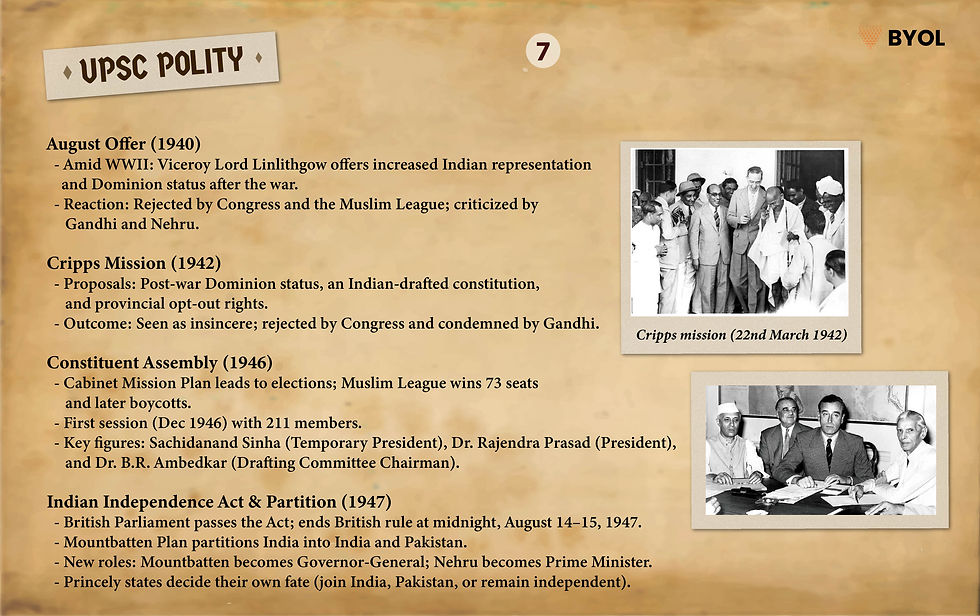
Governance would continue under the Government of India Act of 1935 until the new constitutions were framed, but the dominions could make modifications to the Act.
The British monarch lost the power to veto bills, a right now held by the Governor-General, who could assent to bills in the monarch’s name.
The Governor-General and provincial governors became constitutional heads, acting on the advice of their respective cabinets.
The title "Emperor of India" was dropped from the royal titles of the British King.
The Secretary of State ceased appointing civil servants, but existing members would continue to enjoy their benefits.
At midnight on August 14-15, 1947, British rule ended, and power was transferred to the new dominions of India and Pakistan. Lord Mountbatten became the first Governor-General of India, and Jawaharlal Nehru became the first Prime Minister. The 1946 Constituent Assembly became the Parliament of India.


Love your content thank you 🙏🏼
Must read content for serious UPSC Aspirants.👏
Good content
Helpful content😊
Most precise content for UPSC PRE .